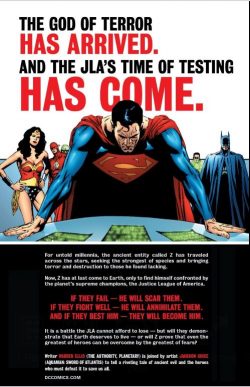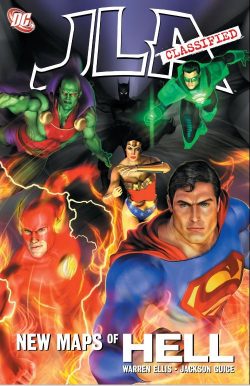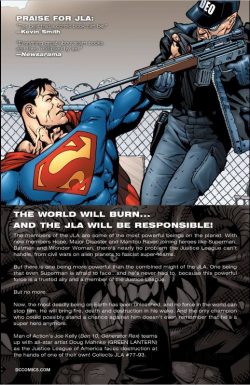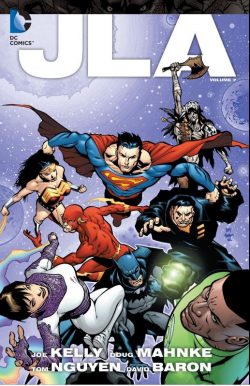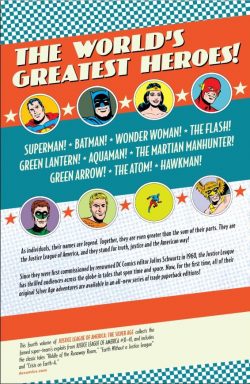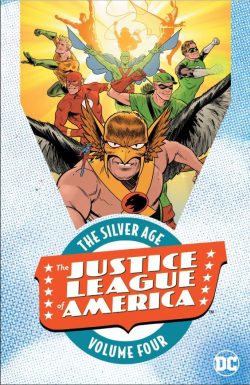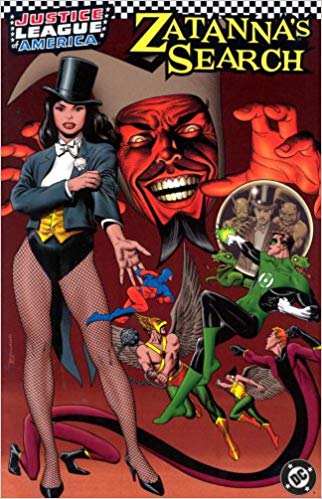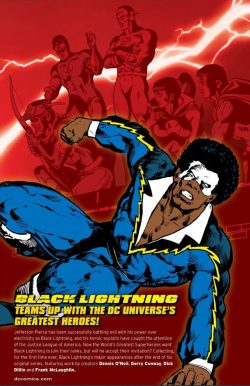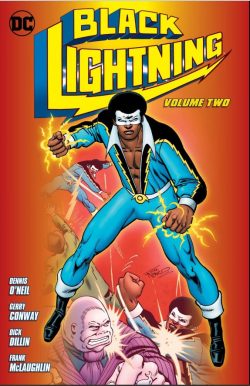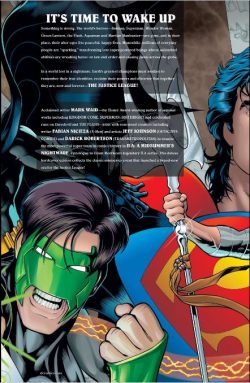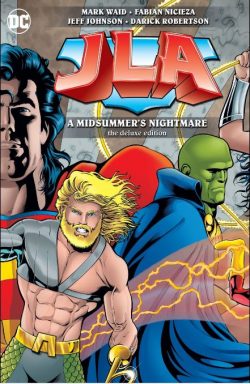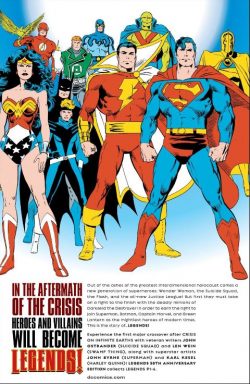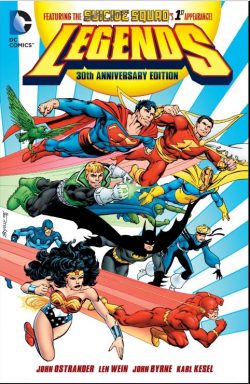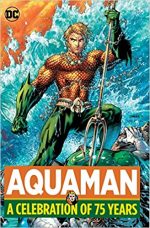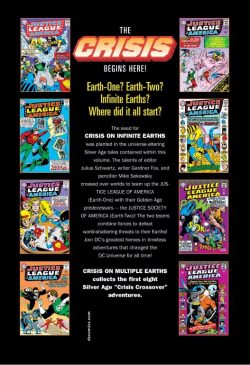
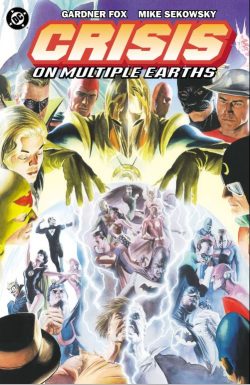
By Gardner Fox, Mike Sekowsky, Bernard Sachs & Sid Greene (DC Comics)
ISBN: 978-1-56389-895-2
As I’ve frequently mentioned before, I was one of the “Baby Boomer†crowd which grew up with Julie Schwartz, Gardner Fox and John Broome’s tantalisingly slow reintroduction of Golden Age superheroes during the halcyon, eternally summery days of the early 1960s. To me those fascinating counterpart crusaders from Earth-Two weren’t vague and distant memories rubber-stamped by parents or older brothers – they were cool, fascinating and enigmatically new.
…And for some reason the “proper†heroes of Earth-One held them in high regard and treated them with obvious deference…
The transcendent wonderment began, naturally enough, in The Flash; pioneering trendsetter of the Silver Age Revolution. After successfully ushering in the triumphant return of the superhero concept, the Scarlet Speedster – with Fox & Broome at the writing reins – set an unbelievably high standard for costumed adventure in sharp, witty tales of science and imagination, always illustrated with captivating style and clean simplicity by Carmine Infantino.
The epochal epic that literally changed the scope of American comics forever was Fox’s ‘Flash of Two Worlds’ (Flash #123 September 1961, and reprinted in loads of places, but not here): introducing the concept of alternate Earths to the continuity and by extension the multiversal structure of the future DCU as well as all the succeeding cosmos-shaking yearly “Crisis†sagas that grew from it.
Moreover, where DC led, others followed…
Received with tumultuous acclaim, the concept was revisited months later in Flash #129 which also teasingly reintroduced evergreen stalwarts – Wonder Woman, the Atom, Hawkman, Green Lantern, Doctor Mid-Nite and Black Canary: venerable members of the fabled Justice Society of America. Clearly Editor Schwartz had something in mind…
That tale directly led into the veteran team’s first meeting with the Justice League of America and the start of an annual tradition. When ‘Flash of Two Worlds’ brought us the notion of Infinite Earths and multiple iterations of costumed crusaders, public pressure had begun almost instantly to agitate for the return of the Greats of the “Golden Ageâ€. The Editorial powers-that-be were hesitant, fearing too many heroes would be silly and unmanageable, or worse yet, put readers off. If they could see us now…
These innovative adventures generated an avalanche of popular and critical approval (big sales figures, too) so inevitably the trans-dimensional tests led to the ultimate team-up in the summer of 1963.
This gloriously enthralling volume – available in trade paperback and digital incarnations – is the first of a glorious sequence of collections celebrating Infinite Diversity in Infinite Costumes (extra fanboy kudos if you get where I filched that from!) and re-presents the first four JLA/JSA convocations: stunning superhero wonderments which never fail to astound and delight. It also comes with context-conveying Introduction ‘1 & 2 = Crisis’ from wonder-scribe Mark Waid detailing even more cool facts behind the phenomenon…
The comic book catharsis commences with the landmark ‘Crisis on Earth-One’ and ‘Crisis on Earth-Two’ (from Justice League of America #21-22, August & September 1963) combining to form one of the most important stories in DC history and arguably one of the most crucial tales in American literature: at least the stuff with pictures in it.
Written by Fox and compellingly illustrated by Mike Sekowsky & Bernard Sachs, the yarn finds a coalition of assorted villains from each Earth plundering at will, meeting and defeating the mighty Justice League before insufferably imprisoning them in their own secret mountain HQ…
Temporarily helpless, “our†heroes contrive a desperate plan to combine forces with the champions of another Earth to save the world – both of it – and the result is pure Fights ‘n’ Tights majesty.
It’s impossible for me to be totally objective about this saga. I was a drooling kid in short trousers when I first read it and the thrills haven’t diminished with this umpty-first re-reading.
This is what superhero comics are all about!
The buying public clearly agreed and one year later ‘Crisis on Earth-Three’ and ‘The Most Dangerous Earth of All!’ (Justice League of America #29-30) reprised the team-up of the Justice League and Justice Society, when the super-beings of a third alternate Earth discover the secret of trans-universal travel.
Unfortunately, Ultraman, Owlman, Superwoman, Johnny Quick and Power Ring are villains on a world without heroes who see the costumed crime-busters of the JLA/JSA as living practise dummies to sharpen their evil skills upon.
With this cracking thriller the annual summer get-together became solidly entrenched in heroic lore, giving fans endless entertainment for years to come and making the approaching end of school holidays less gloomy than they could have been.
(A little note: although the comic cover-date in America was the month by which unsold copies had to be returned – the “off-sale†deadline – export copies to Britain travelled as ballast in freighters. Thus, they usually went on to those cool, spinning comic-racks in the actual month printed on the front. You can unglaze your eyes and return to the review proper now, and thank you for your patient indulgence of an old and misty-eyed man…)
The third annual event was a touch different; a largely forgotten and rather experimental tale wherein the educationally-challenged and extremely larcenous Johnny Thunder of Earth-1 wrests control of the genie-like Thunderbolt from his otherworld counterpart: employing its magical powers to change the events which created of all Earth-1’s superheroes.
With Earth-1 catastrophically altered in #37’s ‘Earth – Without a Justice League’, it’s suddenly up to the JSA to save the day in a gripping battle of wits and power before Reality is re-established in #38’s concluding chapter ‘Crisis on Earth-A!’.
Veteran inker Bernard Sachs retired before the fourth team-up, leaving the amazing Sid Greene to embellish the gloriously whacky saga that closes this tome: one springing out of the global “Batmania†craze engendered by the Batman television series…
A wise-cracking campy tone was fully in play, acknowledging the changing audience profile and this time the stakes are raised to encompass the destruction of both planets in ‘Crisis Between Earth-One and Earth-Two’ and ‘The Bridge Between Earths’ (Justice League of America #46-47, August & September 1966).
Here a bold – if rash – continuum warping experiment drags the twin sidereal worlds towards an inexorable hyper-space collision. Meanwhile, making matters worse, an awesome anti-matter being uses the opportunity to break into and explore our positive-matter universe whilst the heroes of both worlds are distracted by the destructive rampages of monster-men Blockbuster and Solomon Grundy.
Peppered with wisecracks and “hip†dialogue, it’s sometimes difficult to discern what a cracking yarn this actually is, but if you’re able to forgive or swallow the dated patter, this is one of the very best plotted and illustrated stories in the entire JLA/JSA canon. Furthermore, the vastly talented Greene’s expressive subtlety, beguiling textures and whimsical humour add unheard-of depth to Sekowsky’s pencils and the light and frothy comedic scripts of Fox.
These titanic tales won’t suit everybody and I’m as aware as any that in terms of the “super-powered†genre the work here can be boiled down to two bunches of heroes formulaically getting together to deal with extra-extraordinary problems. In mature hindsight, it’s obviously also about sales and the attempted revival of more sellable super characters during a period of intense commercial competition between DC Comics and Marvel.
But I don’t have to be mature in my off-hours and for those who love costumed dramas, who crave these cunningly constructed modern mythologies and actually care, this is simply a grand parade of straightforward action, great causes and momentous victories.
…And since I wouldn’t have it any other way, why should you?
© 1963, 1964, 1965, 1966, 2002 DC Comics. All Rights Reserved.

